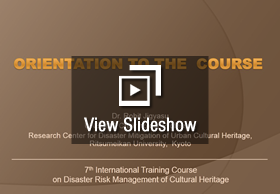

This section provides a brief summary of each module of the course and detailed teaching strategies which may be used to communicate key concepts. It draws heavily from the International Training Courses that have been organised at R-DMUCH, but at the same time provides various alternative strategies that may be used for different formats of the course. Each module is based on the integrated disaster risk management framework and is further divided into smaller sections that may be dealt with individually for exhaustive training programmes, and combined together for shorter courses.
Before introducing the subject matter to participants it is important to orient them to the objectives and methodology of the course and also enable interaction between participants and resource persons.
Read More...
Participants introducing themselves and presenting their case study projects

Introduction of the Course to the participants
Before introducing the subject matter to participants it is important to orient them to the objectives and methodology of the course and also enable interaction between participants and resource persons. This may be done through an orientation session facilitated by the course coordinators and instructors, briefly introducing the organisers, objectives and structure of the course while also discussing what expectations the participants have about the course.
Ice-breaking exercises may be organised in order to ensure that participants not only are introduced but also feel comfortable in each other’s company. The orientation session can also address logistical concerns that participants may have. This is especially important in the case of courses that cater to an international audience.
Participants who are unfamiliar with the host organisation or host country’s cultural aspects may benefit from this type of session. Informal interaction should be encouraged at this stage so that participants are receptive to team exercises through the length of the course. Finally during this session, an opportunity should be provided to the participants to make brief presentations on the cultural heritage and disaster management context in their home countries and the challenges and initiatives for disaster risk management of cultural heritage.